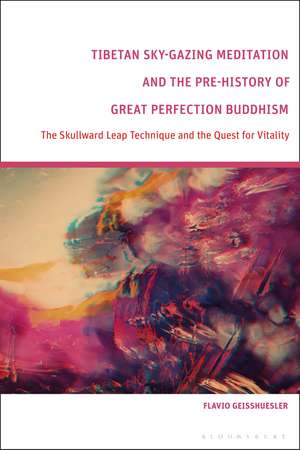Tibetan Sky-Gazing Meditation and the Pre-History of Great Perfection Buddhism: The Skullward Leap Technique and the Quest for Vitality
Autor Flavio Geisshuesleren Limba Engleză Hardback – 7 feb 2024
Preț: 510.60 lei
Preț vechi: 731.31 lei
-30% Nou
Puncte Express: 766
Preț estimativ în valută:
97.73€ • 106.20$ • 82.15£
97.73€ • 106.20$ • 82.15£
Carte tipărită la comandă
Livrare economică 21 aprilie-05 mai
Preluare comenzi: 021 569.72.76
Specificații
ISBN-13: 9781350428812
ISBN-10: 1350428817
Pagini: 240
Ilustrații: 10 bw illus
Dimensiuni: 156 x 234 mm
Greutate: 0.51 kg
Editura: Bloomsbury Publishing
Colecția Bloomsbury Academic
Locul publicării:London, United Kingdom
ISBN-10: 1350428817
Pagini: 240
Ilustrații: 10 bw illus
Dimensiuni: 156 x 234 mm
Greutate: 0.51 kg
Editura: Bloomsbury Publishing
Colecția Bloomsbury Academic
Locul publicării:London, United Kingdom
Caracteristici
Refines our understanding of meditation by presenting contemplative exercises that resemble "quests for vitality,"adventurous expeditions into unfamiliar realms, which emphasize the centrality of qualities like courage and curiosity, imagination and creativity, or playfulness and excitement.
Notă biografică
Flavio A. Geisshuesler is the Khyentse Macready Senior Lecturer for Tibetan Buddhism at the University of Sydney, Australia.
Cuprins
Acknowledgements Skullward Leap Meditation and the Quest for VitalityPart 1: The Mythical-Historical Conception of Vitality1. The Sky as Source of Vitality in Ancient Tibet2. The Tibetan Empire and the (Incomplete) Buddhicization of Vitality3. The Rise of the New Schools and the Circularity of VitalityPart 2: The Embodied-Technical Circulation of Vitality4. The Four Visions and the Meaning of Vitality5. The Preliminary Practices and the Domestication of Vitality6. The Dzogchen Body and the Internalization of VitalityPart 3: The Institutional-Material Crystallization of Vitality7. Vitality and the Buddhist Path8. The Introductions Between Language and Vitality9. Dzogchen Yogis and the Forgotten ShamansConclusion: Meditation and the Adventure of LifeReferences
Recenzii
A bold work of scholarship, this book yields new perspectives on Dzogchen meditation. By tracing mythical, cultural, ritual, and psychological dimensions of the famed Skullward Leap technique through a quest for vitality and a hidden narrative of the sky-deer cult, scholars and practitioners are invited to reevaluate resonances and repercussions of the Heart Essence contemplative system in Tibetan Buddhism.
This striking book places Dzogchen firmly within Tibet's own early medieval culture andreligious concerns, opening up new views of Tibetan Buddhist meditation as a whole.
This striking book places Dzogchen firmly within Tibet's own early medieval culture andreligious concerns, opening up new views of Tibetan Buddhist meditation as a whole.
